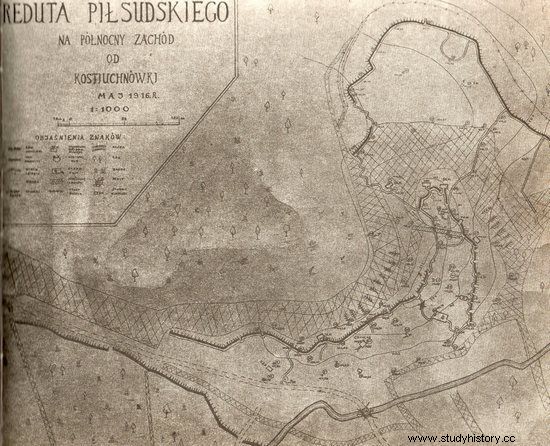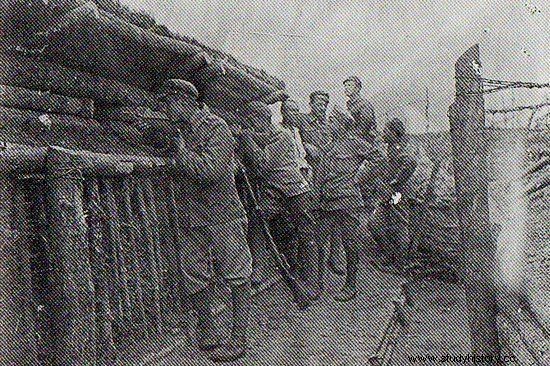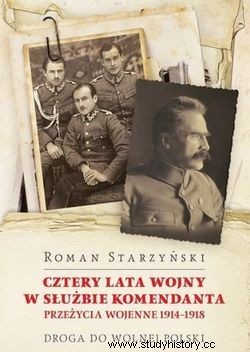The Battle of Kostiuchnówka from the beginning of July 1916 is one of the bloodiest clashes in the history of the 1st Legions Brigade. Before it happened, however, the shooters spent many weeks bored in the trenches. It is from this period that the most famous legend of the Legions dates from that the Russians intended to blow up Piłsudski's redoubt.
The soldiers of the 1st Brigade reached Kostichnówka at the beginning of May 1916. They relieved their colleagues from the 2nd Brigade there. The position above the Styr was comfortable by all means. Perfectly prepared trenches, comfortable dugouts, beautiful weather and little enemy activity meant that there was not much to worry about.
In fact, the only danger - as Roman Starzyński noted in his memoirs "Four Years of War in the Commandant's Service" - seemed to undermine the Russian, which was allegedly being done under our redoubt.
The aforementioned redoubt was the most advanced fragment of the Polish (and officially Austrian) fortifications. It was about 100 paces away from the enemy position and there was also a constantly more lively exchange of fire . No wonder then that a rumor spread among the legionnaires that the enemy was planning to blow up this thorn in the side of Muscovites.
The Russians are undermining?
According to Starzyński, the story of the undermining was inherited in bequest after the 2nd Brigade. In turn, the later Prime Minister of the Second Polish Republic, Sławoj Felicjan Składkowski stated in his diary that the whole matter was publicized by Captain Albin Fleszar "Satyr". He was to hear murmurs of underground work in his dugout, which he immediately informed his superior, who was none other than Major Michał Żymierski. The same one who will become the communist marshal of the Polish Army after many years.

Piłsudski's Redoubt, plan taken tachymetrically by the sergeant of the engineer company of the 1st Brigade, Eng. Komocki. The plan and the signature (original spelling) come from the "Album of Polish Legions", Warsaw 1933.
It doesn't matter who was the first to bring the story with the undercut to light. More importantly, Żymierski decided that the matter cannot be underestimated. That same evening the major, accompanied by Składkowski and several other officers, went to the headquarters of the 6th Battalion commanded by Fleszar.
After listening to the gathered people for a long time there were murmurs, sometimes deaf, like digging, and sometimes resonant, like working with pickaxes. The crowd heard the same sounds in the neighboring dugout. The situation was getting serious. What if it's not a rumor and the Russians are actually going to break Polish positions quietly ?!
For absolute certainty, the next day, all soldiers within 100 paces of the murmurs and knocks were removed. In absolute silence, the legionnaires' ears reached the unexplained sounds again.
Now the crowd was sure that something suspicious was happening under their feet. Even the specially invited chief of the sapper company, citizen Dąbkowski, although skeptical about the undermining, could not explain the murmurs - Składkowski recalled years later.
In connection with the above, a decision was made that, just in case, the entire sandy "peninsula", on which the redoubt was located, should be dug crosswise in order to thwart the enemy's plans. The sappers started their work sharply and after a few hours a trench a few meters deep was created, which was later to be used to build a shelter under the redoubt.
After all, despite going deeper and deeper, there was no trace of the Russian undermining! After further deliberations it was decided not to continue digging, but to put on a large load of ecrazite and throw it into the air . It was supposed to definitely thwart enemy schemes.

Polish fortifications with Kostiuchnówka. The photo comes from the book "Four Years of War in the Commandant's Service" (Erica Publishing Institute 2012).
As planned, so was done. The time of the big "boom" is set for 1.30 am on the night of May 8th to 9th. Of course, for the sake of the safety of the soldiers, Piłsudski's redoubt was abandoned during the explosion. However, not everything went according to plan and the whole operation - to the great dissatisfaction of the numerous legionaries gathered - was slightly delayed.
Undermine? What kind of undermining again?

Finally, as Starzyński noted, at 3.20 there was an explosion. But he was so weak that it left almost no impression . Apparently, the force of the explosion went deeper. The Russian mine did not explode at all.
Worse still, no traces of Russian work were found after the explosion. At least after the big-small boom, Składkowski and his colleagues stopped hearing the strange noises. Of course, ordinary soldiers started to mock the sappers: and a little bit of the commander of our regiment, repeating the humorous letter of the 1st regiment entitled "Peace Conference" that "whoever digs holes under whom ... must have a lot of ecrazite".
Well, after all, there was this undermining, was it not there? The mystery was solved a few days later. During the raid behind enemy lines, Captain Stefan Biernacki "Dąb" captured a Polish prisoner of war, serving in the tsarist army. This categorically contradicted the undermined story . However, there is nothing bad that would not turn out to be good. As a result of the "underground" history, the legionaries gained a solid shelter, which was to be very useful to them less than two months later.
